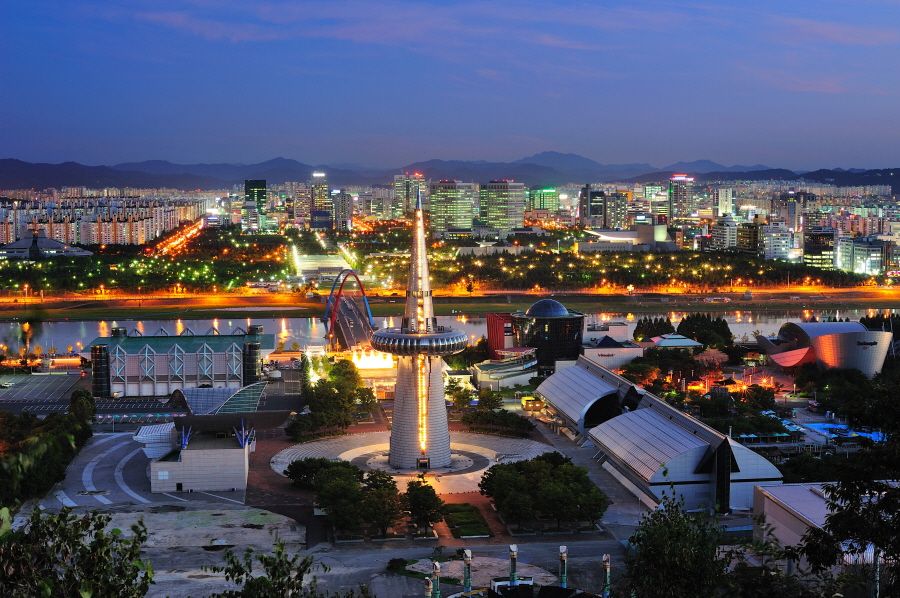
大田广域市(朝鲜语:대전광역시/大田廣域市 Daejeon gwangyeoksi */?)位于韩国中部,是韩国第五大城市,于2012年及之前曾为忠清南道的首府。2010年人口为150万。大田是韩国京釜线、湖南线、京釜高速公路、湖南高速公路的交汇处,是韩国铁道公社总部所在地。世宗特别自治市位于大田广域旁边。目前韩国关税厅、统计厅、特许厅、调达厅、兵务厅、山林厅、文化财厅、中小企业厅等12个政府机关位于大田市。
大田是韩国科技中心,许多韩国研究机构像韩国科学技术院(KAIST),韩国电子和电信研究院(ETRI),韩国航空宇宙研究院(KARI)都位于大田市。位于大田儒城区的大田科技园内驻有79个研究机构和28个韩国政府主管的研究所,拥有5万人以上研究人员。大田于1998年主办成立了世界科学城市联盟(WTA)。 目前,WTA已经发展成为拥有32个国家67个机构的国际组织,作为UNESCO的正式咨询机构,与众多国际组织展开了积极的合作。1993年,大田市还曾举办1993年世界博览会。
Daejeon ist mit 1.539.154 Einwohnern die fünftgrößte Stadt Südkoreas. Es liegt zwischen den Provinzen Chungcheongbuk-do und Chungcheongnam-do und ist die Hauptstadt von Chungcheongnam-do (abgek.: Chungnam), obwohl es politisch eine eigenständige Einheit bildet.
Die Stadt ist vollständig von bewaldeten Hügeln umschlossen; auf gut ausgebauten Wegen kann Daejeon umwandert werden. Der Stadtbezirk Yuseong liegt im Nordwesten von Daejeon und ist bekannt für seine heißen Quellen. Hier befindet sich auch der Hauptcampus der Chungnam-Nationaluniversität.
大田広域市(テジョンこういきし、朝鮮語: 대전광역시)は、大韓民国の都市。韓国で5番目の大都市である。5区と79行政洞よりなる。現在は広域市に位置づけられ、道には属さないが、1988年までは忠清南道に属していた。
西には名山・聖山として知られた鶏龍山がそびえる。古来より近郊の儒城温泉が知られていたが大きな町はなく、公州所属の農村地帯に過ぎなかった。ゆえにこの地域を「大きな田畑」を意味する固有語でハンバッ(한밭、Hanbat)と曖昧に指し示していた。日本統治下の自治体統廃合の際に「大田」と漢字が当てられ、さらに京釜線・湖南線などが開通して交通の要衝となり急速に発展、大きな都市となった。
大田国際博覧会が1993年に開催されたほか、市内の儒城区にハイテク団地「大徳研究団地」を有するなど科学技術都市として知られる。1973年に研究学園団地として指定された大徳研究団地は、韓国科学技術院(KAIST)や韓国電子通信研究院(ETRI)など政府・民間の研究所100以上が集中しており、原子力や宇宙開発、生命工学などの研究を行っている。また特許庁や統計庁など首都機能の一部が大田に分散されており、韓国鉄道公社(KORAIL)の本社も置かれている。
Daejeon (Korean: [tɛ̝.dʑʌn] (![]() listen)) is South Korea's fifth-largest metropolis. Daejeon had a population of over 1.5 million in 2010.[2] Located in the central region of South Korea, Daejeon serves as a hub of transportation and is at the crossroads of major transport routes. The capital Seoul is about 50 minutes away by KTX high-speed train.
listen)) is South Korea's fifth-largest metropolis. Daejeon had a population of over 1.5 million in 2010.[2] Located in the central region of South Korea, Daejeon serves as a hub of transportation and is at the crossroads of major transport routes. The capital Seoul is about 50 minutes away by KTX high-speed train.
Daejeon is one of South Korea's administration hubs with the Daejeon Government Complex (Other administrative hubs: Seoul, Gwacheon and Sejong). The Korean administration in the 1980s decided to relocate some of its functions from Seoul, the national capital, to other cities. Currently, 12 national government offices, including Korea Customs Service, Small and Medium Business Administration, Public Procurement Service, National Statistical Office, Military Manpower Administration, Korea Forest Service, Cultural Heritage Administration, and Korean Intellectual Property Office, as well as Patent Court of Korea, are located in Daejeon. Korail, Korea Water Resources Corporation, and Korea Minting and Security Printing Corporation are also headquartered in the city.
Daejeon has 18 universities, including KAIST and Chungnam National University. Daejeon has earned its name as "Asia's Silicon Valley" and "high technology city".[3] The city hosted the Taejon Expo '93 and the International Mathematical Olympiads in 2000. Several important research institutes are based in the city.[3]
Daedeok Innopolis (Daedeok Research and Development Special Zone) is composed of 28 government-funded research institutions, as well as 79 private research institutes with as many as 20,000 researchers. In addition, Daejeon established the World Technopolis Association (WTA) in 1998 with the view of realizing regional development through international cooperation with world science cities. The WTA has grown to have 67 members from 32 countries, and it actively cooperates with many international organizations including UNESCO as its official consultative body.
Daejeon (en hangeul : 대전 en hanja : 大田: grand champ) est une ville située au centre de la Corée du Sud, légèrement à l'ouest. Elle se trouve à 150 km au sud de Séoul.
Malgré l'adoption du nouveau système de romanisation du hangeul, les anciennes écritures Taejŏn et Daejon restent très utilisées. Daejeon signifie grand champ en coréen, ce que l'on retrouve dans l'appellation vernaculaire hanbat (한밭) du même sens : 한밭 大學校 Université Hanbat, par exemple.
C'est la cinquième ville de Corée, elle compte 1 530 650 d'habitants pour 539,84 km2 (en 2011) et se dénote par son profil scientifique. Elle a été la capitale du Chungcheong du Sud de 1932 à 2012.
Daejeon (대전광역시?, 大田廣域市?, Daejeon gwang-yeoksiLR) è una città nel centro della Corea del sud. È la quinta città più grande della Corea con una popolazione di 1.537.324 nel giugno 2012.
Dal punto di vista amministrativo è contemporaneamente capoluogo della provincia del Sud Chungcheong e città metropolitana autoamministrata con rango di provincia.
A partire dal 1997 è stata avviata la costruzione del "Daejeon Government Complex" nel quadro dello sforzo di decentrare alcuni uffici governativi della capitale Seul; tra gli altri Daejeon è sede di Statistics Korea, l'ufficio statistico coreano.
Daejeon (hangul: 대전, RR: Daejeon, MR: Taejŏn)? pronunciado: [tɛ̝.dʑʌn], oficialmente Ciudad Metropolitana de Daejeon (hangul: 대전광역시, RR: Daejeon-gwangyeoksi, MR: Taejŏn-gwangyŏkshi)?, es una de las seis ciudades metropolitanas que, junto a las nueve provincias, la ciudad especial y la ciudad autónoma especial, forman Corea del Sur.
Se ubica en el centro del país, a 167 kilómetros al sur de Seúl, y es la capital de la provincia de Chungcheong del Sur. Es la quinta ciudad más poblada, con aproximadamente 1.5 millones de habitantes.
Тэджо́н (кор. 대전 [tɛ̝.dʑʌn]) — город прямого подчинения в центре Южной Кореи, административный центр провинции Чхунчхон-Намдо. Официальное название города — Город-метрополия Тэджон (кор. 대전광역시 Тэджон-гванъёкси). Пятый по величине город Кореи c населением 1 564 тыс. жит[1]. Считается научно-технической столицей Южной Кореи.







